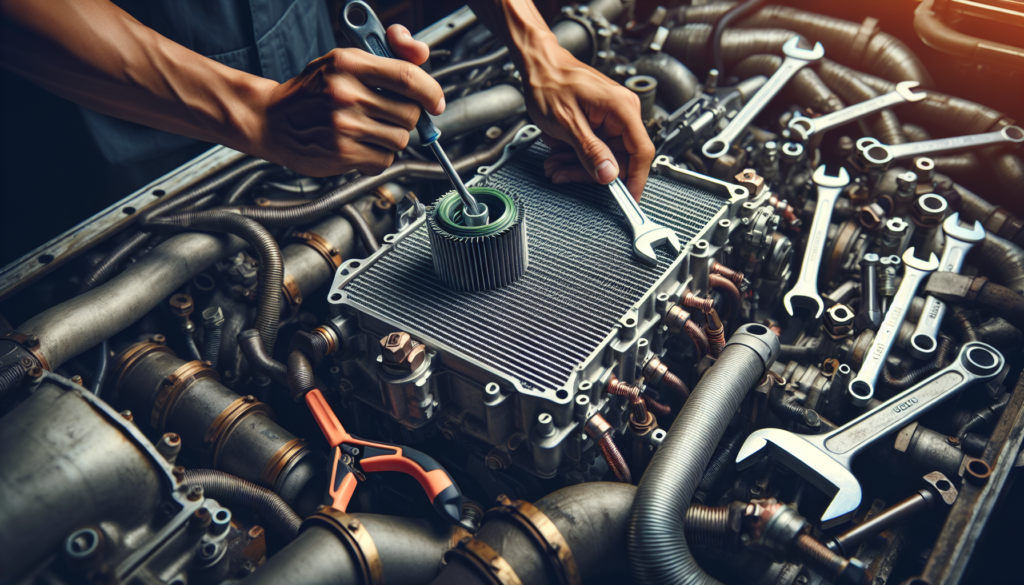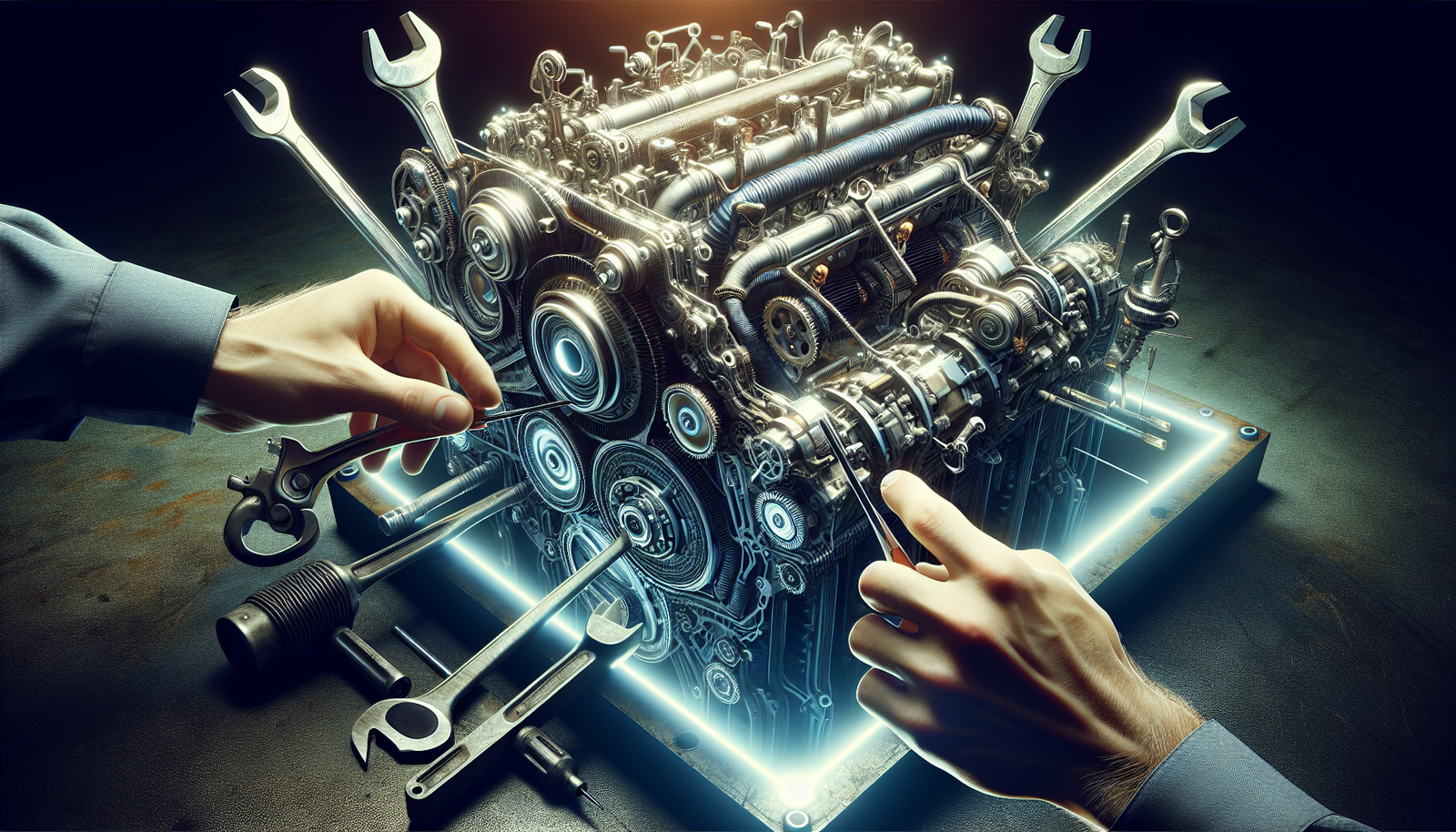Prepare for a unique journey where you’ll become an ace in servicing your boat engine’s cooling system. Sure, it might sound complex now, but by the end of this informative read, you’ll have the tools and knowledge to maintain your vessel in top condition all by yourself. The article will educate you on the critical aspects of a boat engine’s cooling system, practical step-by-step procedures to service it, and the signs you should never ignore. It’s all about empowering you to conquer your boating challenges head on.
Understanding the Importance of a Boat Engine’s Cooling System
Just as the human body needs its circulatory system to function properly, a boat engine cannot operate without a robust cooling system. A cooling system is an engine’s ally, helping it brave all types of water conditions while protecting it from any potential thermal harm.
Role of a Cooling System in a Boat Engine
Essentially, the cooling system in a boat engine is responsible for keeping the engine at an optimal temperature. If an engine overheats, it can lead to severe damage which is usually expensive to repair. The cooling system continually cools the engine, preventing it from overheating, ensuring the longevity of the engine and keeping you safe while enjoying your time on the water.
Why Regular Maintenance is Crucial
Regular maintenance of the engine’s cooling system is key in keeping your boat running smoothly and efficiently. Neglecting this aspect of your boat’s upkeep can lead to prolonged poor performance and potential engine failure in the worst case scenario. Consistent and proper maintenance keeps the system running optimally and saves you costly repairs, ensuring your peace of mind.
Potential Risks of Neglecting the Cooling System
Should you decide to ignore regular maintenance of your boat’s cooling system, you could be heading for some headaches. Neglected cooling systems are prone to issues such as corrosion, scaling and clogging, which hamper the system’s ability to cool the engine leading to overheating. Ultimately, this oversight could result in a total engine failure and leave you stranded out at sea.
Detecting Problems in Your Boat Engine’s Cooling System
How do you know if there’s trouble brewing within your cooling system? Well, the key to spotting problems lies in understanding the signs, conducting tests and knowing when it’s time to call in an expert.
Common Signs of Cooling System Problems
The most obvious sign of a problem is the engine temperature. If it’s running higher than usual, you have a cooling system issue. Other symptoms to look out for include coolant leakage, rust colored exhaust smoke and a sweet-smelling odor. All these can be cause for alarm and signal a need for immediate inspection.
Diagnostic Tests for the Cooling System
A few simple diagnostic tests can help you comprehend the condition of your cooling system. Checking for coolant leaks, pressure testing the system, inspecting the thermostat and checking the heat exchanger are all effective ways to diagnose the state of your cooling system. They also provide a good starting point for any necessary maintenance or repair.
When to Seek Professional Help
If the common signs persist or are beyond your understanding, it might be time to seek professional help. While you may be an enthusiastic DIY-er, certain jobs need a professional hand. Professionals have the necessary skills and experience to handle complicated issues that may arise.

Gathering Necessary Materials and Tools
Like any undertaking, preparation is key; having the right tools and safety gear will make your work easier and safer.
Essential Tools for Cooling System Maintenance
A few basic tools are necessary for proper cooling system maintenance: a wrench-set, socket set, screwdrivers, pliers, a seal pick, and scrub brushes. You will also require an engine manual, coolant tester, and marine grease for this process. Remember to store all these tools in an organized manner; it will save you loads of time when working on the cooling system.
Safety Equipment You Will Need
Safety is paramount. Personal protective equipment (PPE) such as gloves, safety glasses, and a dust mask are a must-have. These will protect you from accidental splashing of coolant, inhalation of dust particles and prevention of injuries from any sharp components.
Finding Quality Replacement Parts
When it comes to replacement parts, always aim for quality. Cheaper parts may save you money in the short term but may cause bigger issues down the line. Always go for manufacturer-approved or OEM parts; moreover, don’t forget a good supply of coolant.
Steps to Flush the Boat Engine’s Cooling System
Flushing your boat engine’s cooling system removes any dirt, salt or rust build-up, optimizing the performance of the cooling system, and the engine.
Preparatory Measures Before Flushing
Before you even begin the flushing process, ensure the engine is cool to prevent any burns from the hot coolant. Next, you will need to remove the thermostat and replace it with a dummy thermostat. Additionally, drain the old coolant and check the condition of hoses and seals, replacing any that show signs of wear and tear.
The Flushing Process Step By Step
Flushing the system is fairly straightforward: attach a garden hose to the flushing port, turn on the engine and let the water run for about 10-15 minutes. Monitor the temperature, ensuring it doesn’t go above 140 degrees Fahrenheit. This flushing removes all the debris and contaminants from the system.
Post-Flushing Procedure
Once flushing is complete, turn off the engine and disconnect the hose, allowing all water to drain out of the system. Replace the dummy thermostat with a functional one and fill the system with a mixture of water and coolant. Restart the engine and let it run to circulate the fresh coolant and check the system for any leaks.

Changing the Coolant in Your Boat Engine’s Cooling System
While flushing removes most of the dirt and debris, changing the coolant ensures your engine does not overheat.
Why Changing Coolant is Essential
Over time, coolant loses its efficiency. The coolant’s ability to transfer heat is essential to keep the engine from overheating. Hence, changing the coolant is crucial to keep the engine functioning efficiently.
Selecting the Right Coolant
Not all coolants are created equal, and using the wrong type can actually damage your engine. Therefore, always opt for coolant recommended by the manufacturer to ensure your cooling system works optimally.
Procedure to Change the Coolant
To change the coolant, you first need to drain the old coolant. Once drained, pour in the new coolant up to the manufacturer’s recommended level. Make sure to use a 50/50 mix of distilled water and coolant. Lastly, before taking your boat out, run the engine to check for any leaks and to circulate the new coolant.
Inspecting and Cleaning the Heat Exchanger
The heat exchanger swaps heat from the engine coolant with the seawater to help maintain the engine’s temperature.
Function of the Heat Exchanger in the Cooling System
The heat exchanger is essentially a radiator that cools down the engine’s coolant. It performs a crucial role in cooling the boat engine by taking the heat from the coolant and transferring it to the seawater.
Steps to Inspect the Heat Exchanger
Inspection of the heat exchanger primarily involves checking for any visible damage such as leaks or corrosion. Additionally, you should check the coolant passage for any blockages, which may prevent the efficient transfer of heat.
Cleaning the Heat Exchanger Properly
To clean the heat exchanger, you need to disassemble it first. Once disassembled, soak it in a vinegar solution to remove any scale build-up. Afterwards, scrub it gently with a scrub brush, rinse with water, let it dry and then reassemble.

Servicing the Water Pump
The water pump is an essential component of the cooling system as it circulates coolant, preventing the engine from overheating.
Role of Water Pump in Cooling System
The water pump serves as the heart of your boat’s engine cooling system, pumping coolant throughout the engine to absorb the heat. It’s a critical aspect of the whole system, and without it, your engine could potentially overheat leading to catastrophic damage.
Signs of a Failing Water Pump
Some common signs that your water pump is failing or has failed include a coolant leak, high temperature readings, noise from the water pump, or steam coming from the radiator. If you spot any of these signs, the water pump needs immediate attention.
Reparing vs Replacing a Water Pump
In most cases, once a water pump fails it is more advantageous to replace it entirely, rather than attempting a repair. Replacing your water pump ensures more longevity and better performance. Moreover, given the critical role of the water pump in the cooling system, it’s best not to take any chances.
Preventing Corrosion in the Cooling System
Preventing corrosion in a cooling system prolongs the life of its components and helps the engine perform at an optimal level.
Understanding How Corrosion Can Occur
Corrosion in the cooling system can occur when the balance of the coolant’s chemical components is off, which could be due to using the wrong type of coolant, mixing different kinds of coolant, or neglecting to change the coolant regularly.
Using Anti-Corrosion Solutions
To prevent corrosion, use anti-corrosion solutions in your coolant mixture. These include anti-freeze and coolant additives. Always remember to follow the manufacturer’s instructions when adding these to your coolant mixture.
Additional Anti-Corrosion Measures
Regularly flushing your cooling system and changing the coolant keeps the corrosive substances at bay. Moreover, avoiding the use of any harsh cleaners will also help to protect your cooling system from corrosion.

Maintaining the Thermostat
A thermostat is essentially the gatekeeper which governs the coolant flow in the engine, therefore its maintenance is crucial.
Role of the Thermostat in Cooling System
The thermostat basically controls the flow of coolant around the engine based on its temperature. When the engine is cold, it restricts the flow of coolant to allow the engine to warm up, then opens up to allow a full flow once the engine is at operating temperature.
Signs of a Bad Thermostat
Common signs of a bad thermostat include overheat, underheat, erratic temperature changes, and leaks around the thermostat housing. If your thermostat shows these signs, it’s most probably heading for a replacement.
Replacing a Faulty Thermostat
Replace a faulty thermostat immediately to prevent any engine damage. Always use a replacement part recommended by the manufacturer and ensure it is installed correctly. Once replaced, test your engine and monitor the temperature to ensure it’s functioning correctly.
Seasonal Maintenance of a Boat Engine’s Cooling System
Just as seasons come and go, so should your boat engine’s cooling system maintenance. Conducting regular seasonal maintenance can help keep your engine running smoothly all year long.
Preparing the Cooling System for Winter
Before winter sets in, you need to winterize your cooling system. This involves draining all the water and replacing it with anti-freeze to prevent any potential freezing and subsequent damage.
Seasonal Checks and Adjustments
As the seasons change, always be diligent in performing regular checks and adjustments to the cooling system. Monitor coolant levels, check for leaks, and ensure all components are working properly.
Benefits of Regular Seasonal Maintenance
Regular seasonal maintenance of your boat’s cooling system can identify any potential issues early, helps preserve performance and fuel economy, and ultimately extends the lifespan of your boat engine. It’s these small preventative measures that keep your boat engine reliable and your voyages smooth.
By extending the life of your engine and preventing potentially enormous repair costs, proper maintenance of your boat engine’s cooling system is a great investment. The aforementioned steps will help keep your engine healthy, giving you a great return on your investment and a peace of mind while cruising the open waters.

